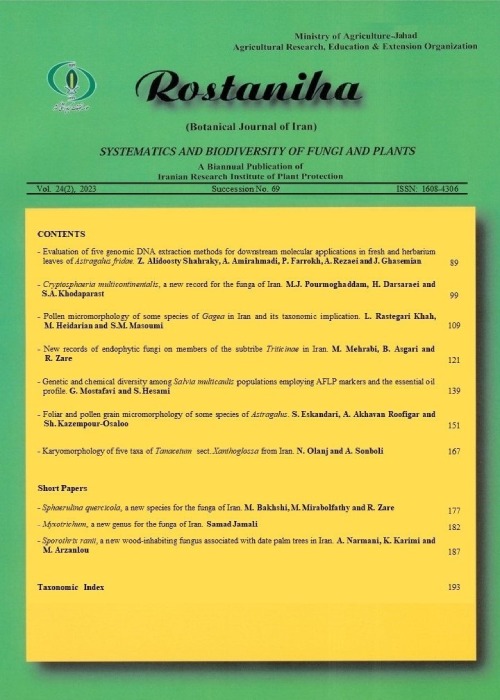irst report of Pluteus cinereofuscus for mycobiota of Iran
Author(s):
Article Type:
Research/Original Article (دارای رتبه معتبر)
Abstract:
Through continuous sampling of agaric fungi conducted from 2014–17 at different locations of Eslamabad-e Gharb (Iran), two specimens belonging to the genus Pluteuswere collected. At the collection site, GPS coordinates; habit, habitat and macro-morphological characters were recorded and photographed. Microscopic features including basidiospores, basidia, cystidia and pileipellis were observed, measured and illustrated using a light microscope, OLYMPUS BX51. Primer pairs ITS1/ITS4 were used to amplify and sequencing of ITS rDNA. Phylogenetic analyses of ITS-rDNA sequence data using Maximum Likelihood approaches with 1000 bootstrap replicates were performed using the MEGA6 software (Tamura et al. 2013). Based on the morphological characteristics along with data obtained from ITS rDNA sequences, two species including Pluteuscinereofuscus and P. nanus were identified. Pluteusnanus has been previously reported from Iran (Saber 1991, Saber & Mehravaran 2004), but P. cinereofuscus is reported here as a new record for the mycobiota of Iran. Morphological characteristics of this species are as follows:Pileus up to 4.0 cm in diameter, when young hemispherical, then expanding to plano-convex with low umbo, hardly striate at margin; at first hygrophanous and olive-brown in color, later olivaceous grey at centre and brown-grey at margin (Fig. 1a). Gills free, moderately crowded, at first white, then turns to pink (Fig. 1b). Spore print brownish pink. Stipe tall, cylindrical, up to 5.0 cm high and less than 1.0 cm in diameter, white in color and pale grey at base. Ring absent. Pileipellis consisted of globose elements (Fig. 1c). Basidiospors smooth, subglobose to ellipsoid and 8–9 × 6.3–6.9 μm (Fig. 1h). Basidia clavate, four-spored (Fig. 1d). Pleurocystidia in various shapes of cylindrical, clavate, utriform or lageniform (Fig. 1e-g). Comparing the sequence of this specimen with the sequences of P. cinereofuscus available in the GenBank database using Basic Local Alignment Search Tool (BLAST) algorithm, represented only 94% similarity. This may be attributed to the complex nature of P. cinereofuscus.Nevertheless, clear morphological characteristics along with the results of phylogenetic analyses represented in figure 2, confirmed the identity of specimens. Pluteus is a species-rich genus belonging to the family Pluteaceae with more than 300 species worldwide (Kirk et al. 2008). The genus is characterized by pink spore prints, free gills and the absence of ring and volva. These fungi are saprophytic and grow mainly on wood or wood remains (Hansen & Knudsen 1992). According to the literature, prior to this study, 16 species of Pleuteus have been reported from Iran (Saber 1991, 1993, 2000, Saber & Esmaeili Taheri 2002, 2004, Saber & Mehravaran 2004, Ershad 1995, Arefipour et al. 2006, Asef 2007). Most of these reports have been related to the identification of macrofungi in the north of the country. Indeed, other regions including Kermanshah province have poorly studied. Therefore, greater attention to identifying macrofungi in this region and other poorly investigated areas in the country is needed.
Specimen examined: Iran: Kermanshah province, Islamabad-e Gharb, Darbadam, solitary on the remains of the leaves and twigs of oak trees, E46º 25´ 54˝, N34º 01´08˝, 1700 m, 12 May 2016, E. Seidmohammadi (IRAN 16960 F).
Specimen examined: Iran: Kermanshah province, Islamabad-e Gharb, Darbadam, solitary on the remains of the leaves and twigs of oak trees, E46º 25´ 54˝, N34º 01´08˝, 1700 m, 12 May 2016, E. Seidmohammadi (IRAN 16960 F).
Keywords:
Language:
Persian
Published:
Botanical Journal of Iran, Volume:19 Issue: 2, 2019
Pages:
192 to 195
magiran.com/p1943058
دانلود و مطالعه متن این مقاله با یکی از روشهای زیر امکان پذیر است:
اشتراک شخصی
با عضویت و پرداخت آنلاین حق اشتراک یکساله به مبلغ 1,390,000ريال میتوانید 70 عنوان مطلب دانلود کنید!
اشتراک سازمانی
به کتابخانه دانشگاه یا محل کار خود پیشنهاد کنید تا اشتراک سازمانی این پایگاه را برای دسترسی نامحدود همه کاربران به متن مطالب تهیه نمایند!
توجه!
- حق عضویت دریافتی صرف حمایت از نشریات عضو و نگهداری، تکمیل و توسعه مگیران میشود.
- پرداخت حق اشتراک و دانلود مقالات اجازه بازنشر آن در سایر رسانههای چاپی و دیجیتال را به کاربر نمیدهد.
دسترسی سراسری کاربران دانشگاه پیام نور!
اعضای هیئت علمی و دانشجویان دانشگاه پیام نور در سراسر کشور، در صورت ثبت نام با ایمیل دانشگاهی، تا پایان فروردین ماه 1403 به مقالات سایت دسترسی خواهند داشت!
In order to view content subscription is required
Personal subscription
Subscribe magiran.com for 70 € euros via PayPal and download 70 articles during a year.
Organization subscription
Please contact us to subscribe your university or library for unlimited access!


